Author: Cade Jobe
Less commonly used in modern brewhouses, 6-row barley malt was quite popular among early American brewers not only because of its general availability, but it also possesses a higher diastatic power than its 2-row counterpart. Put simply, diastatic power refers to the amount of enzymes available in malt to convert starches into fermentable sugar, which is especially important when using non-diastatic adjunct grains such as corn and rice.
In addition to the differences in enzymatic content, 6-row barley also tends to have more carbohydrates and less protein than 2-row barley, which many believe has a perceptible impact on flavor. Indeed, tasters in a past xBmt were able to reliably distinguish a pale lager made entirely with 6-row malt from one made with 2-row malt, indicating each may contribute unique organoleptic characteristics.
In discussing the aforementioned xBmt on a recent episode of The Brülosophy Podcast, I found it interesting how similar the beers were in terms of original and finishing gravities, as I expected the version made with 6-row to have better conversion. This made me wonder how things would’ve looked had both beers included a dose of non-diastatic adjunct grain, so I designed an xBmt to test it out!
| PURPOSE |
To evaluate the differences between an adjunct-laden American Lager produced with either 2-row or 6-row malt.
| METHODS |
To keep the variable as isolated as possible, I went with a very simple American Lager recipe where flaked rice made up 40% of the grain bill.
Crossing Paths
Recipe Details
| Batch Size | Boil Time | IBU | SRM | Est. OG | Est. FG | ABV |
|---|---|---|---|---|---|---|
| 5.5 gal | 60 min | 15.7 | 3.1 SRM | 1.039 | 1.009 | 3.94 % |
| Actuals | 1.039 | 1.009 | 3.94 % | |||
Fermentables
| Name | Amount | % |
|---|---|---|
| Rahr 2-Row OR Rahr 6-Row Pale Malt | 6.625 lbs | 59.89 |
| Rice, Flaked | 4.437 lbs | 40.11 |
Hops
| Name | Amount | Time | Use | Form | Alpha % |
|---|---|---|---|---|---|
| Tettnang | 30 g | 60 min | Boil | Pellet | 3.9 |
Yeast
| Name | Lab | Attenuation | Temperature |
|---|---|---|---|
| Global (L13) | Imperial Yeast | 77% | 32°F - 32°F |
Notes
| Water Profile: Ca 115 | Mg 17 | Na 13 | SO4 70 | Cl 81 |
Download
| Download this recipe's BeerXML file |
I made a single large starter of Imperial Yeast L13 Global a day before brewing.
The next day, I started off by collecting the full volume of water for each batch, adjusting both to my desired mineral profile, then setting the electric controllers to heat them up.
I then weighed out and milled the different malts for each batch.
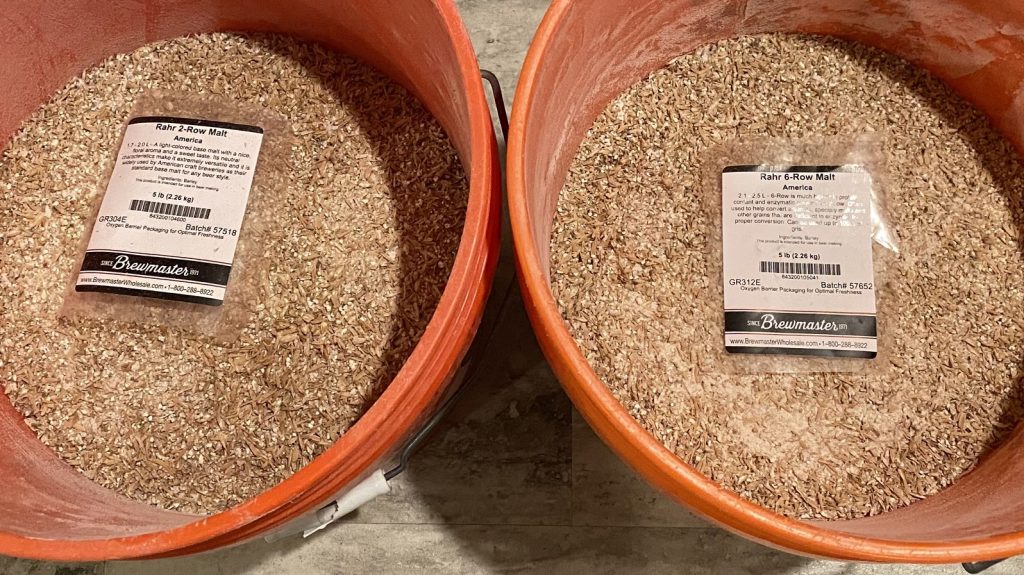
With the water properly heated, I added the grains, turned the pumps on to recirculate, and set the controllers to maintain my intended mash temperature of 148°F/64°C.
While the mashes were resting, I weighed out the kettle hop additions.
Following each 60 minute mash rest, I raised the grain baskets out of the kettles and let them drain. The worts were then boiled for 60 minutes with hops added at the times listed in the recipe.
When the boils were complete, I quickly chilled the wort then took hydrometer measurements showing both were at slightly different OGs with the 2-row batch being slightly lower.
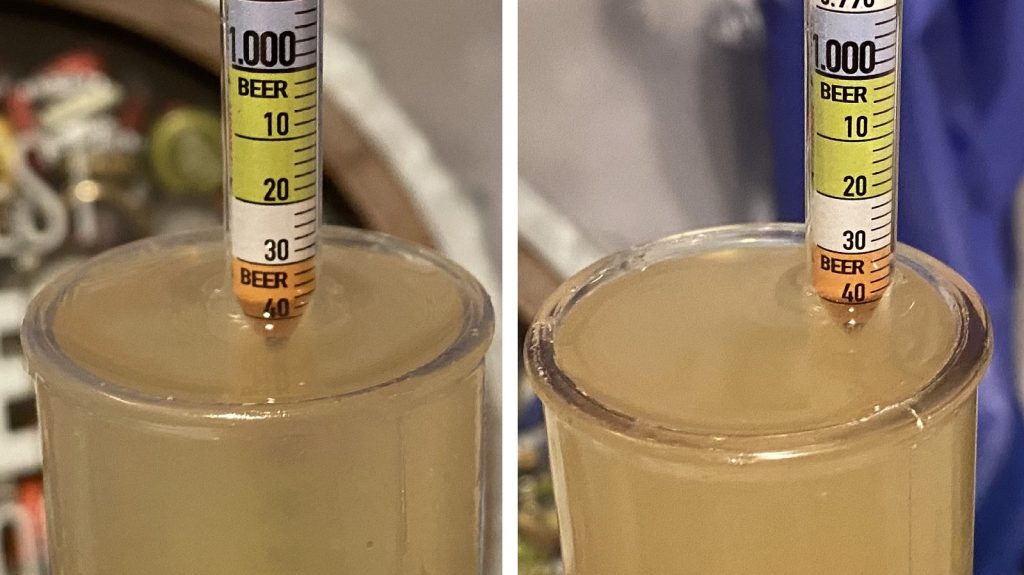
After transferring the worts to sanitized fermenters and placing them next to each other in my fermentation chamber, I allowed them to finish chilling to my desired fermentation temperature of 50°F/10°C before evenly splitting the yeast starter between them. After 5 days, I raised the temperature to 55°F/13°C and left them alone for another week before taking hydrometer measurements showing a small difference in FG.
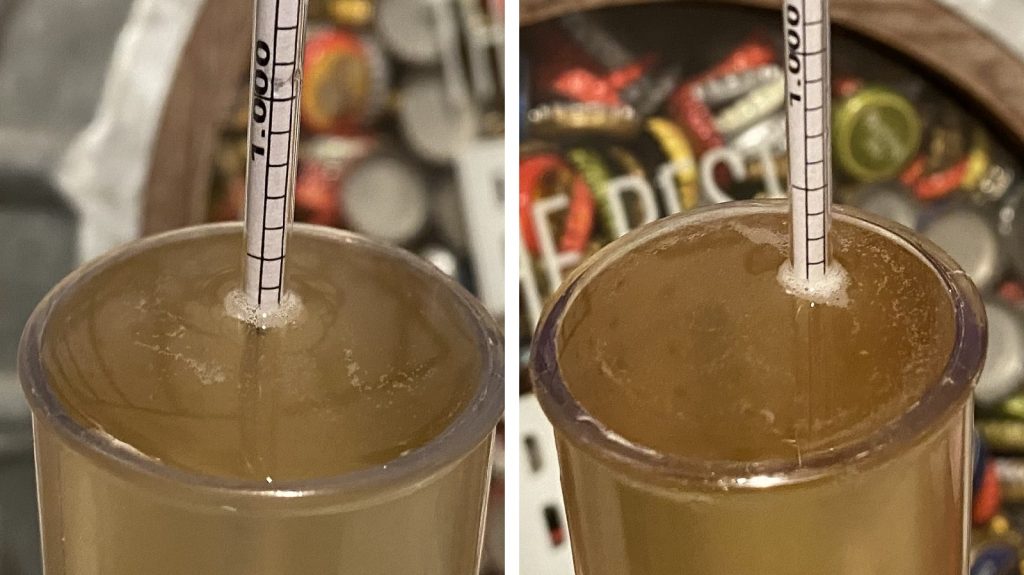
At this point, the beers were pressure transferred to CO2 purged kegs and placed on gas in my keezer where they were allowed to lager for 2 weeks before they were ready for evaluation.

| RESULTS |
A total of 22 people of varying levels of experience participated in this xBmt. Each participant was served 1 sample of the beer made with 2-row malt and 2 samples of the beer made with 6-row malt in different colored opaque cups then asked to identify the unique sample. While 12 tasters (p<0.05) would have had to accurately identify the unique sample in order to reach statistical significance, 11 did (p=0.08), indicating participants in this xBmt were unable to reliably distinguish an American Lager made with 40% flaked rice and either 60% 2-row malt or 6-row malt.
My Impressions: Out of the 5 semi-blind triangle tests I attempted, I correctly identified the odd-beer-out 3 times. To me, these beers were identical in every way, leaving me to guess in each of my triangle test attempts. Despite their simplicity and the use of rice, both beers were incredibly refreshing and delicious!
| DISCUSSION |
While it’s likely American brewers of yore initially used 6-row malt because that’s what was most readily available at the time, many soon came to realize it was beneficial given its higher enzymatic content, which allowed for better conversion when using non-diastatic adjunct grains like rice and corn. The gradual shift away from 6-row to 2-row malt was likely due, at least in part, to the perceived better flavor of the latter, which may explain why it remains the most common type of brewing barley today. Interestingly, tasters in this xBmt were unable to reliably distinguish an American Lager made with 40% flaked rice and either 60% 2-row malt or 6-row malt.
In regard to the apparent lack of a sensorial difference between these beers, especially given how simple the recipe was, it’s easy to presume both 2-row and 6-row malts contribute similar enough flavors to be largely indistinguishable. However, this goes against a prior xBmt where tasters could tell apart beers made entirely with either type of malt, leaving me to wonder if perhaps the inclusion of the flaked rice somehow reduced the flavor impact of each malt. On a more objective level, the beer made with 6-row was 0.003 OG points higher than the 2-row version, which may very well be a function of the higher diastatic power of 6-row encouraging more conversion of the starches in the flaked rice.
I’m lucky enough to have never struggled with conversion in my brewing, whether using non-diastatic adjuncts or not, so I don’t really feel like I have a need to use 6-row barley malt. My hunch is that modern 2-row malts are so well modified these days that they do a perfectly fine job breaking down the starches in adjunct grains like rice and corn, leaving the choice to use 6-row up to personal preference.
If you have any thoughts about this xBmt, please do not hesitate to share in the comments section below!
Support Brülosophy In Style!
All designs are available in various colors and sizes on Amazon!
Follow Brülosophy on:
FACEBOOK | TWITTER | INSTAGRAM
If you enjoy this stuff and feel compelled to support Brulosophy.com, please check out the Support page for details on how you can very easily do so. Thanks!


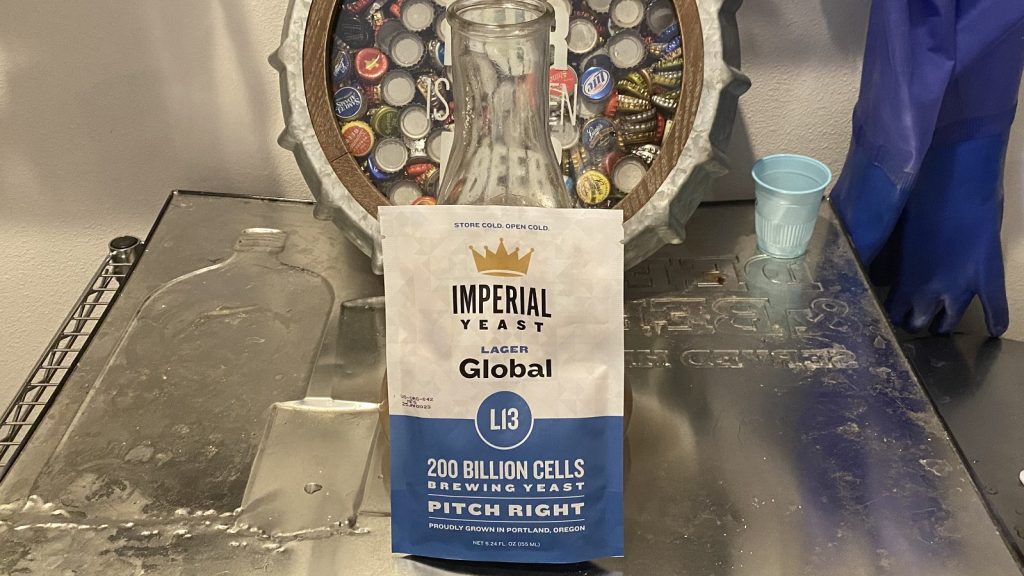
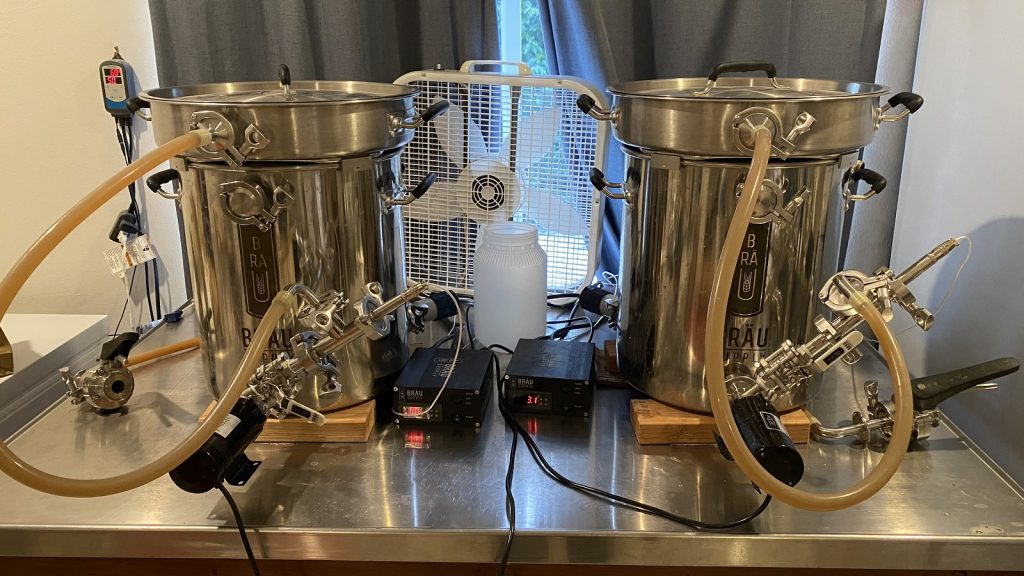
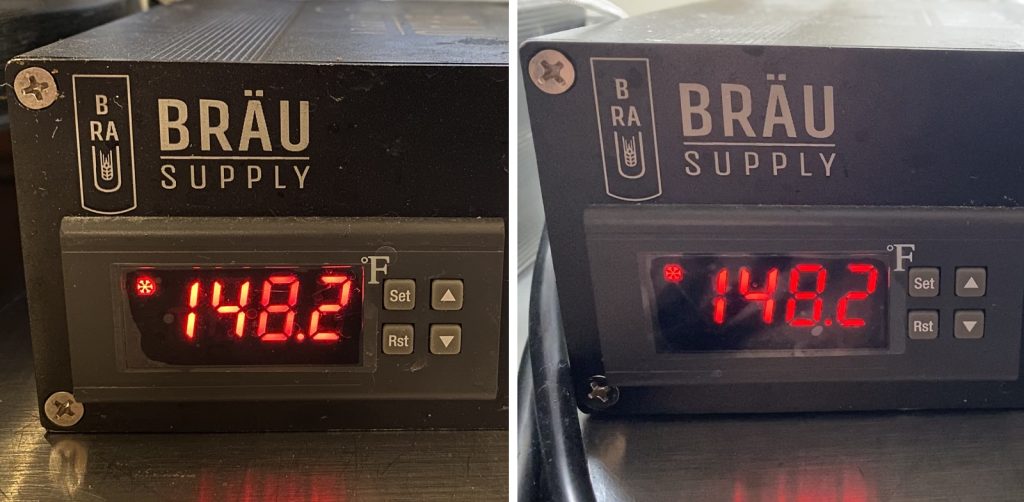
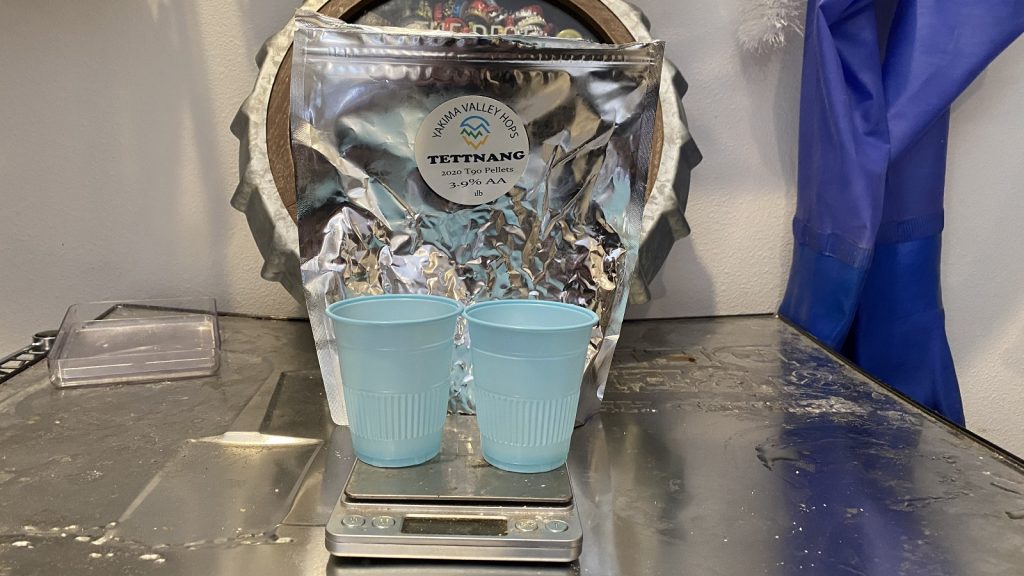
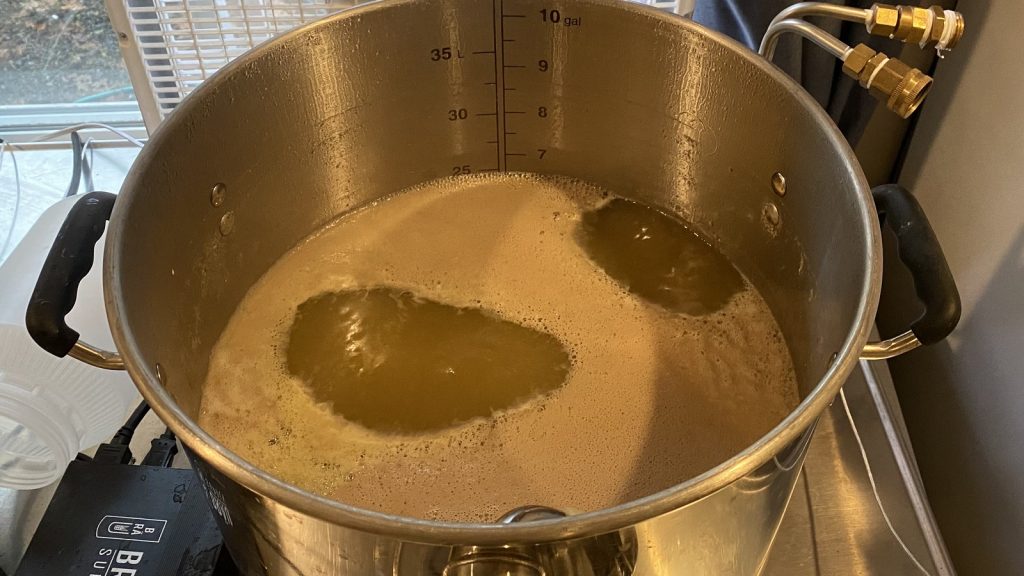











7 thoughts on “exBEERiment | Impact 6-Row Malt Has On An Adjunct-Laden American Lager”
Any idea why the OG was so far (8 to 11 pts) below expected?
I suspect that my mill is drifting. Best guess.
Just wondering: Why does the caption under the OG picture say 1.036 and 1.039 while the recipe details section says the actual OG measurement was 1.047?
It’s a typo in the XML. We’ll get it updated.
Gotcha! I see you updated it, and actually now it says the original estimated OG was 1.039 and estimated FG was 1.009. So you planned for this brew being sub-4%? Is that the norm for this style? Just wondering because I’ve never made this style before, but it seems super crushable, so I’m interested in following your lead with your recipe.
P.S. I love the BruLab!
must remember “organoleptic” next time playing scrabble!
“6-row barley also tends to have more carbohydrates and less protein than 2-row barley”
I’m assuming this is typo as well. It’s the opposite from what was stated.
Modern American 2 row has been bred over the years to produce a high level of diastatic power, European 2 row barley has a much lower DP, typically 80. It’s not uncommon to see American 2 row with 120-140 DP, as opposed to 6 row with 140-150 DP for 6 row. It’s the malt it self that carries over the DP, the level of modification really has no bearing on the level of DP.
Still a cool experiment. It’s good to see that 2 row can convert 40% rice. Thanks for doing this.